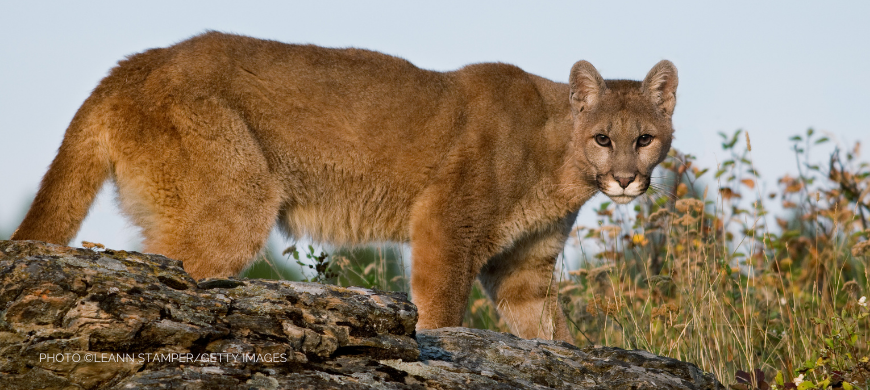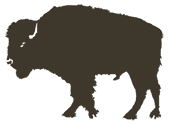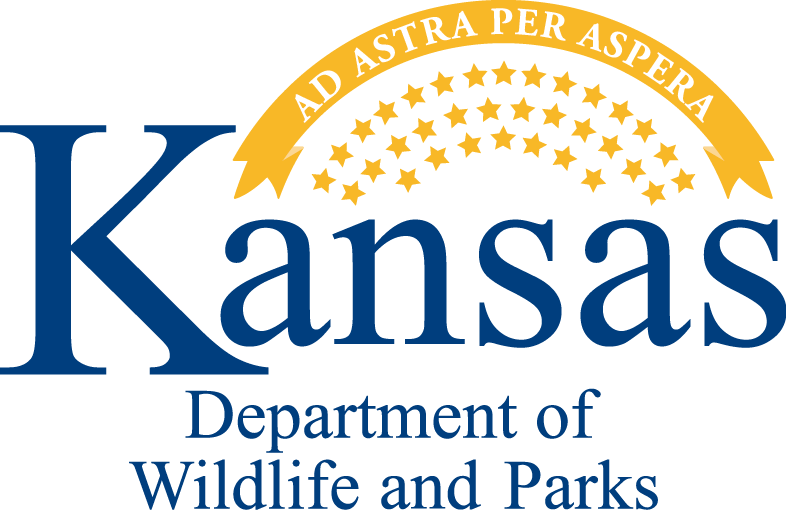Mountain Lions in Kansas

Mountain lions (Puma concolor) were once common across North and South America including throughout Kansas. By the late 1800s, mountain lion populations in the United States had declined significantly for many reasons including unregulated hunting and habitat loss. In 1904, the last documented Kansas mountain lion was shot and killed in Ellis County.
As mountain lion populations rebounded in the West, these solitary cats gradually began to roam closer to Kansas. The first confirmed mountain lion in Kansas in modern times was documented in Barber County in 2007. Since then, mountain lions have been confirmed in Kansas more than 100 times, though it is common for one animal to be documented many times.
In most cases, mountain lions documented in Kansas have been travelling through the state and are unlikely to remain or return to the area seen. However, there have been some instances of what appears to be an individual mountain lion documented multiple times in the same general areas over several weeks or more.
• Mountain lions are also called cougars, panthers, pumas, and catamounts.
• Mountain lions are generally solitary animals, only traveling together when mating or a mother caring for young.
• There is no record of mountain lions attacking livestock in Kanas. Even in states with established mountain lion populations, livestock predation is rare.
• Mountain lions are generally elusive, avoiding encounters with humans whenever possible.
• There has never been any evidence of breeding mountain lions in Kansas in modern times.
• The chance of encountering a mountain lion in Kansas is extremely low.
Was it really a mountain lion? The Kansas Department of Wildlife and Parks investigates all reports of mountain lions in the state. Most turn out to be the much smaller bobcat and tracks are usually dog prints. Here are a few tips to help you tell the difference.
• Mountain lions are big, up to 8 feet in length from nose to tip of the tail and approximately 30 inches in height at the shoulder. Compare this to bobcats that are about 24 inches at the shoulder but only 3 feet in length—about twice the size as a housecat.
• Mountain lions are mostly one color, ranging from yellowish to tan, with distinct black markings at the tip of the tail and on the muzzle of the face. Only mountain lion kittens have spots, which fade around 1 year of age.
• Mountain lions have a long tail, not the short tail of the bobcat.
• Mountain lions do not have tufts of fur on their face or distinctive white markings on the back of their ears like bobcats.
• Mountain lion tracks do not typically show claw marks like is often seen in dog or coyote tracks.
If you think you have seen a mountain lion in Kansas, we encourage you to let us know by reporting the details here. In some cases, a KDWP biologist might follow up with you to collect more information to confirm the sighting.

The Kansas Department of Wildlife and Parks has confirmed mountain lion sightings in 47 of Kansas's 105 counties: Allen, Atchison, Barber, Barton, Chase, Cheyenne, Comanche, Decatur, Elk, Ellis, Ford, Geary, Gove, Gray, Greeley, Hamilton, Jefferson, Jewell, Kiowa, Labette, Leavenworth, Logan, Marshall, McPherson, Morris, Morton, Nemaha, Osborne, Pottawatomie, Rawlins, Reno, Republic, Riley, Rooks, Russel, Saline, Sedgwick, Shawnee, Sherman, Stafford, Stanton, Sumner, Thomas, Trego, Wabaunsee, Wallace, and Washington.
Mountain lions could be seen in any habitat type in Kansas. Riparian areas—the wooded banks along rivers and streams—are the most likely places but mountain lions will also travel across open areas like crop fields and grasslands.
The Kansas Department of Wildlife and Parks has never stocked, relocated, or released mountain lions in Kansas—and has no plans to do so in the future.
Mountain lions are classified as nongame wildlife in Kansas by state law with no hunting season. In Kansas, it is unlawful to take or possess any wildlife in this state by any means or manner “unless and except as permitted by law or rules and regulations adopted by the secretary.” (K.S.A. 32-1002)
You can contact a local KDWP regional office for more information about legally controlling wildlife:
- Pratt Operations Office
- Hays Region 1 Office
- Topeka Region 2 Office
- Wichita Region 3 Office
- Kansas City District Office
- Dodge City District Office
- Chanute District Office
- Emporia Research and Survey Office
The chance of encountering a mountain lion in Kansas is extremely low. Most of the confirmed mountain lions have been single animals passing through an area, staying for just a few days at most.
Anyone who spends time outdoors can expect to encounter wildlife, but most animals will not attack humans. There are no verified modern accounts of humans being attached by mountain lions in Kansas. Still, it is always best to plan ahead and be prepared for any wildlife encounter. Kansas Department of Wildlife and Parks biologists offer these tips:
• Always be aware of your surroundings. Fresh tracks or killed prey could indicate a mounting lion is in the area.
• Dawn, dusk, and night are when mountain lions are most likely to be active.
• Make noise when in remote areas to avoid surprising wildlife. Like many animals, mountain lions usually avoid encounters with humans.
• Consider carrying a walking stick, bear spray, or other device that could be used for self-defense if necessary.
• If you do encounter a mountain lion, stand your ground and stay facing the animal. Do not turn your back or run away. Keep children close. Try to scare the animal off by making noise and standing tall.
Dates: 01/19/2026 - 01/31/2026
The following unfilled permits are valid during this season using archery equipment only for antlerless whitetails: Resident and Nonresident Archery Either-species/Either-sex permit, Nonresident Archery White-tailed Deer permit, Resident Any-Season White-tailed Deer permit, Hunt-Own-Land Permit (valid for Unit 19), Special Hunt-Own-Land permit (valid for Unit 19), and Antlerless White-tailed Deer permit. A valid hunting license is required, unless exempt by Kansas law. NOTE: Unit 10A is Ft. Leavenworth and is open only to military personnel.







